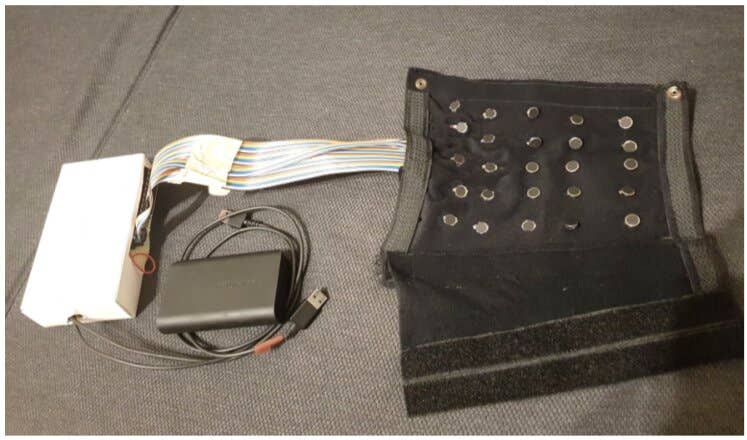Haptic feedback sleeve and goggles allow blind people to ‘see’ with their arm
Researchers have developed a haptic feedback sleeve and goggle system that allows blind people to partially “see” with the skin on their arm

[Jan 27, 2022: Bob Yirka]
Prototype of the haptic sleeve component. (CREDIT: Center for Digital Technology and Management, Technical University of Munich, https://arxiv.org/pdf/2201.04453.pdf)
Two researchers with the Center for Digital Technology and Management, Technical University of Munich, have developed a haptic feedback sleeve and goggle system that allows blind people to partially "see" with the skin on their arm. Manuel Zahn and Armaghan Ahmad Khan published a paper describing their sleeve and goggle system on the arXiv preprint server.
As the researchers note, despite advances in technology aimed at assisting the blind, the best tool for helping to navigate in public is still the cane. In this new effort, the researchers built a system that they believe can help blind people and people with other vision problems to navigate more easily in public places.
The system consists of a pair of goggles fitted with dual infrared cameras. The cameras create a 3D stereoscopic image of the environment in front of the goggles. The imagery is sent to a tiny computer that translates the visual data to haptic data, which is sent to a haptic sleeve. Inside the sleeve is a 5 x 5 array of small pads pressed against the forearm when the sleeve is worn. The pads vibrate as a means of communicating visual data.
Prototype of the goggles which connect to the haptic sleeve. (CREDIT: Center for Digital Technology and Management, Technical University of Munich, https://arxiv.org/pdf/2201.04453.pdf)
Related Stories:
Images that are closer vibrate more strongly than those that are farther away. For example, as a person wearing the system walks into a tunnel, the pads at the periphery of the array will start vibrating, alerting the user to the presence of the walls. If the tunnel is narrow, the pads will vibrate more strongly than if it is wide. Similarly, the pads that represent the outline of a person will vibrate more strongly as that person approaches and then cease as they pass by.
The results of the mapping algorithm for a hallway. (CREDIT: Center for Digital Technology and Management, Technical University of Munich, https://arxiv.org/pdf/2201.04453.pdf)
The researchers point out that their system does not involve use of either the hands or the ears; thus, users can continue to use both to assist in navigating. They note also that because the system uses infrared cameras, it can be used in complete darkness. During testing, they found that users were able to use the system right away and grew more proficient with practice.
Depth maps for pictures in light (top) and dark (bottom). (CREDIT: Center for Digital Technology and Management, Technical University of Munich, https://arxiv.org/pdf/2201.04453.pdf)
More information: Manuel Zahn, Armaghan Ahmad Khan, Obstacle avoidance for blind people using a 3D camera and a haptic feedback sleeve. arXiv:2201.04453v1 [cs.HC], arxiv.org/abs/2201.04453
For more science and technology news stories check out our New Innovations section at The Brighter Side of News.
Note: Materials provided above by Bob Yirka. Content may be edited for style and length.
Like these kind of feel good stories? Get the Brighter Side of News' newsletter.
Tags: #New_Innovations, #Blindness, #Medical_Good_News, #Vision, #Treatment, #Haptic, #Science, #Research, #Technology, #The_Brighter_Side_of_News



